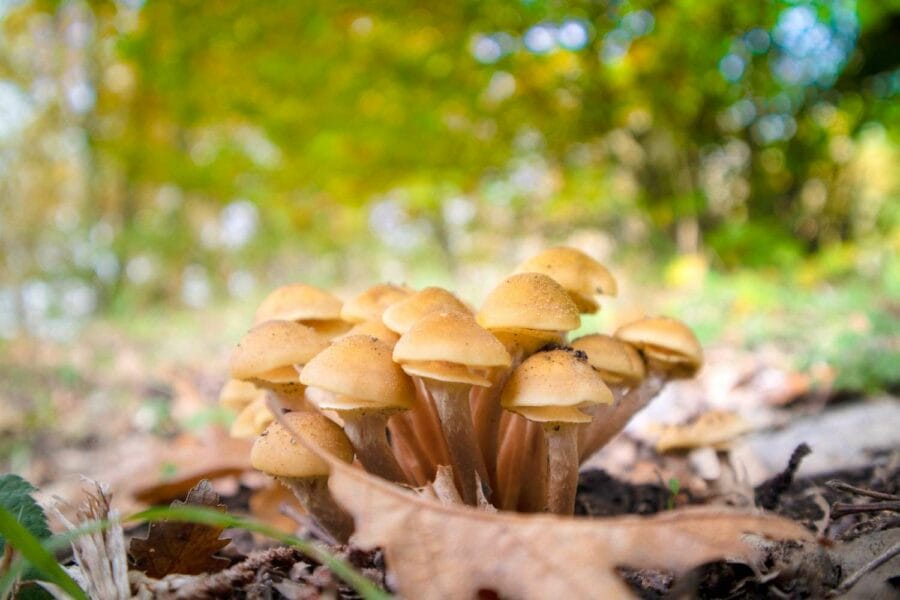Psilocybin, a psychoactive compound found in magic mushrooms, is often used for recreational purposes, known for inducing euphoria and hallucinations.
Beyond its mind-altering properties, research has been conducted into the potential benefits of this compound for chronic pain relief.
In this article, we delve into a case study that investigates the potential role of mushroom microdosing in mitigating chronic pain.
Key Takeaways:
- Microdosing mushrooms may provide both immediate and ongoing pain relief.
- Psilocybin microdosing, in comparison to traditional painkillers, typically has fewer side effects when given in small doses.
- Psilocybin engages with serotonin 2A (5-HT2A) receptors to potentially alleviate pain, among other health conditions.

The Study
The study, named “Microdosing Psilocybin for Chronic Pain: A Case Series“, was led by Dr. Matthew Lyes and his team at the Division of Pain Medicine, Department of Anesthesiology, University of California, San Diego. The study focused on three patients who used small amounts of psilocybin to manage their chronic pain.
Three Patients, One Outcome – Chronic Pain Relief
Patient #1
| AGE/ GENDER: | 37, Male |
| TYPE OF PAIN: | Neuropathic pain below the site of a spinal cord injury. |
| PAIN INTENSITY: | Initially rated 4 to 5/10, escalating to 8/10 later in the day |
| PSILOCYBIN DOSE: | 250 mg of ground mushroom for less than 6 months |
| OUTCOME: | Discontinuation of prescribed pain medication, reduction in muscle spasms, and improved bowel movement. No signs of rebound pain or withdrawal symptoms. |
| The patient noted that while his regular medication merely numbed the pain, psilocybin effectively eliminated it, reducing his average pain level from 5 to 0. | |
Case Study: Subject #2
| AGE/ GENDER: | 69-year-old Female |
| TYPE OF PAIN: | Complex Regional Pain Syndrome (CRPS) |
| INTENSITY OF PAIN: | Generally fluctuates between 5 and 7 out of 10, escalating during physical activity and pain spikes |
| PSILOCYBIN DOSAGE: | Regular consumption of 500 mg for a span of 7 to 10 days with breaks (2 to 3 days) over a year. Dosage increases to 750 mg to 1 gram during bouts of intense pain |
| IMPACT: | Pain is reduced by 80% for a duration of 3-4 hours, slowly returning to original levels after 12 hours. Complete pain relief (90%-100%) lasts for 6-8 hours, reverting to original levels after 18 hours. |
| The subject experiences a reduction in appetite without feeling nauseated. Disorientation or difficulty in walking is observed when the dosage is increased (750 to 1000mg). | |
Case Study: Subject # 3
| AGE/ GENDER: | 40-year-old Female |
| TYPE OF PAIN: | Lumbar Radiculopathy and Neuropathic Pain |
| INTENSITY OF PAIN: | 8 out of 10, increasing to 10 during physical activities |
| PSILOCYBIN DOSAGE: | 1000 mg from a mushroom chocolate bar every two months. |
| IMPACT: | Significant pain relief without any psychoactive effects. Notable improvement in flexibility and overall functionality. Pain slowly reverts to original levels over a period of 2-4 weeks. Repeated dosing enhances control over pain. |
| The subject does not report any significant physical, cognitive, or behavioural side effects. Her mood remains mostly stable. She continues her usual dosage of her SSRI for managing depression during the psilocybin treatment phase. | |
Understanding Psilocybin’s Role in Pain Management
Continuous bodily and visceral pain signals strengthen specific neural pathways due to peripheral and central sensitization, resulting in chronic pain occurrence both physically and emotionally. Psychedelics like psilocybin stimulate 5-HT2A receptors, potentially resetting brain regions associated with neuropathic conditions.
A patient reported experiencing prolonged pain relief for several weeks. This suggests that after directly stimulating the 5-HT2A receptors, there might be a central regulation of pain perception and synaptic adaptability.
Possible Side Effects of Psilocybin vs. Traditional Pain Relievers
| PSILOCYBIN (Based on Research) | TRADITIONAL PAIN RELIEVERS |
| Muscle spasms | Nausea |
| Decreased appetite | Stomach discomfort |
| Bewilderment | Migraines |
| Unsteady walk | Addiction |
| No mood changes | Drowsiness |
Potential Future Studies on Psilocybin
The research team, after studying the experiences of three individuals, has highlighted certain areas that require further research because of their potential benefits.
- Small doses of psilocybin could potentially provide immediate and possibly long-lasting relief from neuropathic pain, without causing physical tolerance or addiction.
- Examine the effects of different treatment approaches when combined with psilocybin. For instance, patient # 3 reported an increased pain-relieving effect when psilocybin was combined with physical therapy.
- Small doses of psilocybin may provide pain relief, even without psychotherapy, as demonstrated in this case study. The researchers propose that incorporating therapeutic guidance could potentially enhance or prolong the therapeutic outcomes.
Study Limitations
Despite the encouraging results seen in the patients, it’s important to bear in mind the limitations observed in the study.
- The small sample size might not be fully representative of all individuals struggling with neuropathic pain.
- The study did not include any subjects who did not respond to psilocybin.
- No assessments were conducted before and after treatment to evaluate the impact of psilocybin on psychiatric conditions like depression and anxiety.
- Most of the data was self-reported by the subjects.
- The interviewer’s presence and potential bias related to psilocybin could have influenced the participants’ responses.
- The study did not investigate the potential placebo effect.
- The study did not ascertain the quantity of psilocybin in each mushroom.
Microdosing Practices using Mushrooms
In our study, both patient #1 and #2 consumed a microdose of psilocybin sourced from dried mushrooms in powder form, whereas patient #3 combined it with chocolate. There are a variety of products specifically designed for psilocybin microdosing, a few of which we’ve detailed below.
Dehydrated Mushrooms
Even though the study does not detail the specific strain utilized, the subsequent strain is an excellent initiation for novices.
- Golden Teacher: This is one of the most prevalent and widely recognized strains of psychedelic mushrooms.
- Amazonian Cubensis: Renowned for its user-friendly nature, it may offer cognitive enhancements.
- Cambodian: The use of Cambodian cubensis mushrooms in microdosing can potentially amplify focus, social awareness, and emotional state.
Microdosing Capsules
- Euphoria Psychedelics – Micro Calm Capsules: This concoction comprises Ashwagandha, Reishi, CBD, Valerian root, and Psilocybin Mushrooms, all acknowledged for their abilities to mitigate anxiety and stress.
- Ground Sounds – Microdose Capsules – Champion Lover: This captivating blend offers three dose options: 50mg, 100mg, or 250mg of pure psilocybin mixed with reishi, cacao, cordyceps, and maca.
- Kind Stranger – Brighten Capsules 250mg: These capsules feature the Golden Teacher strain, acclaimed for inspiring clear thinking, heightened creativity, and improved focus.
Pain Management through Psilocybin
Although research on the analgesic effects of mushrooms is still in the preliminary stages, promising results from anecdotal experiences and small-scale case studies are inspiring optimism.
Such instances underscore the necessity for further exploration of psilocybin’s potential advantages, class=”wp-block-list”>
Microdosing mushrooms can be a valuable tool, particularly for managing chronic pain.
With psilocybin increasingly recognized for its potential in pain relief, the promising findings from case studies offer hope to those grappling with chronic pain.
Frequently Asked Questions
What effects does psilocybin microdosing produce?
Psilocybin mainly stimulates a serotonin receptor known as “5-HT2A” in the prefrontal cortex, leading to two primary outcomes:
- Generation of “Brain-Derived Neurotrophic Factor” (BDNF)
- Enhanced “Glutamate” transmission
Furthermore, psychedelics promote connections between brain regions that typically don’t communicate as much. This distinctive connectivity is a result of psychedelics’ ability to diminish the “Default Mode Network” (DMN) activity, which is tied to several cognitive functions, such as daydreaming, introspection, and reflecting on the past and future.
What is the most celebrated benefit of microdosing mushrooms?
Microdosing can potentially enhance mood, productivity, creativity, and focus. Its most extensively researched benefit is its effect on mental health.
In November 2022, COMPASS Pathways, a mental health company, unveiled the findings from their thorough phase 2b trial, a randomized and double-blind study. Their research indicated that a single dose of psilocybin resulted in significant reductions in depressive symptoms compared to a placebo. Participants who received a higher dose of 25 milligrams showed a lasting antidepressant response at the twelve-week follow-up.
A study published in the Psychiatry Research Journal stated that psilocybin outperforms traditional antidepressant treatments.
How should you determine your dosage?
Start with a 0.1-gram dose of psilocybin mushrooms on the first day. If you don’t achieve the desired effects, you can progressively increase your dose by 0.05 grams on subsequent microdosing days until you find your perfect amount.
People with a history of using psychotropic drugs might need to increase the dose to 0.5 grams to attain the desired effects.
What are the recommended preparations before consuming mushrooms?
class=”wp-block-list”>How often should microdoses of mushrooms be consumed?
A variety of established protocols recommend structured microdosing schedules for psychedelics. These protocols primarily differ in the number of “off” days they incorporate, which are the days you abstain from microdosing.
The most advised protocols propose including 1-3 rest days between microdoses. This aligns with the body’s innate tolerance mechanisms. The three protocols being discussed here are the Fadiman Protocol, the Stamets Stack, and intuitive microdosing.




